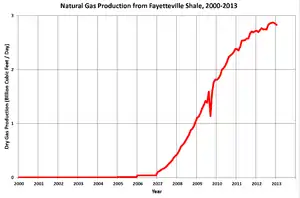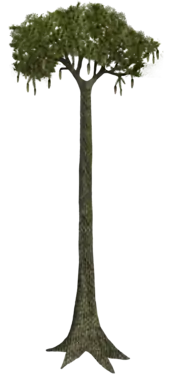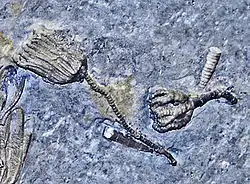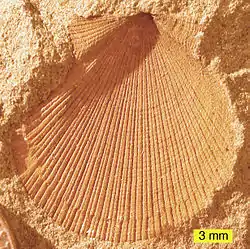Fayetteville Shale
The Fayetteville Shale is a geologic formation of Mississippian age (354–323 million years ago) composed of tight shale within the Arkoma Basin of Arkansas and Oklahoma.[4][7] It is named for the city of Fayetteville, Arkansas, and requires hydraulic fracturing to release the natural gas contained within.
| Fayetteville Shale Stratigraphic range: Carboniferous: Mississippian (Serpukhovian)[1] | |
|---|---|
 Outcrop of the lower Fayetteville Shale in northern Arkansas | |
| Type | Geological formation |
| Sub-units | Wedington Sandstone Member |
| Underlies | Pitkin Limestone,[2] Hale Formation[3] |
| Overlies | Ruddell Shale, Batesville Sandstone[2] Moorefield Shale[3] |
| Area | Arkansas and Oklahoma[4] |
| Thickness | 50 to 500 feet (15 to 152 m) |
| Lithology | |
| Primary | Shale |
| Other | Sandstone, limestone |
| Location | |
| Region | Arkansas |
| Country | |
| Extent | 50 miles (80 km) |
| Type section | |
| Named for | Fayetteville, Washington County, Arkansas |
| Named by | Frederick Willard Simonds[5][6] |
 The Fayetteville formation runs widespread across Arkansas | |
Nomenclature
.png.webp)
Named by Frederick Willard Simonds in 1891, Simonds recognized what is now the Fayetteville Shale as three separate formations overlying the now abandoned Wyman Sandstone: the Fayetteville Shale, the Batesville Sandstone, and the Marshall Shale.[6] In 1904, the name "Fayetteville Shale" replaced all three of these names. The Fayetteville Shale that Simonds recognized is now considered as the lower Fayetteville Shale. Simonds' Batesville Sandstone was found to be the same as the Wyman Sandstone, and replaced the name "Wyman Sandstone", while Simonds' Batesville Sandstone became known as the "Wedington Sandstone Member" presumably after Wedington Mountain. The name Marshall Shale was abandoned and is now known as the upper Fayetteville Shale.[8]
Natural gas

The formation holds natural gas in a fine-grained rock matrix which requires hydraulic fracturing to release the gas.[9] This process became cost-effective in some shales such as the Fayetteville after years of experimentation in the Barnett Shale in North Texas, especially when combined with horizontal drilling.
The Fayetteville Shale play began in July 2004 by Southwestern Energy Company in north-central Arkansas with the Thomas #1-9 vertical well in Conway County, Arkansas.[10] In February 2005, Southwestern Energy drilled the first horizontal well, the Seeco-Vaughan #4-22H, also in Conway County.[11]
The US Energy Information Administration estimated that the 5,853 square miles (15,160 km2) shale play held 13,240 billion cubic ft (375 billion cubic meters) of unproved, technically recoverable gas.[7] The average well was estimated to produce 1.3 billion cubic feet of gas.[12] As of 2018, new drilling in the Fayetteville Shale had ceased and almost 1/5 of wells were abandoned.[13]
Paleontology
Flora
Because the Fayetteville Formation is a marine unit, most of the plants found in the black shales must have been washed into the Carboniferous sea from a landmass. However one unit within the formation, the Weddington Sandstone Member, is a series of river deposited sand beds. Fossil plants from this unit were probably deposited closer to their source.

|
|
Vertebrates
- Carcharopsis wortheni[19]
- Ozarcus mapesae[20]
Echinoderms

- Acrocrinus constrictus[21]
- Agassizocrinus conicus[21]
- Alcimocrinus ornatus[21]
- Allocatillocrinus carpenteri[21]
- Ampelocrinus erectus[21]
- Aphelecrinus exoticus[21]
- A. planus[21]
Cephalopods

|
|
Bivalves

Gastropods

- Euconospira disjuncta [31]
- Mourlonia lativittata [31]
- Patellilabia laevigata [31]
- Platyceras subelegans [31]
Arthropods

Bryozoans
|
|
References
- M. Gordon Jr. and T. W. Henry. 1993. Late Mississippian Productoid Brachiopods Inflatia, Keokukia, and Adairia, Ozark Region of Oklahoma and Arkansas. Paleontological Society Memoir 30:1-29
- Freemen, T. Fossils of Arkansas. Arkansas Geologic Commission.
- "Major Stratigraphic Layers of the Fayetteville Shale Formation". Chesapeake Energy, Inc. Archived from the original on August 20, 2011. Retrieved July 25, 2011.
- Sando, W. 1969. Revision of Some of Girty's Invertebrate Fossils from the Fayetteville Shale (Mississippian) of Arkansas and Oklahoma: Part B- Corals. United States Geologic Survey Professional Paper 606
- Branner, J. (1891). "Introduction". Arkansas Geological Survey Annual Report 1888. 4: xiii.
- Simonds, F.W. (1891). "The geology of Washington County". Arkansas Geological Survey Annual Report 1888. 4: 26, 42–49.
- Reed, Michael (June 2013). "Shale Play Should See Added Capacity Next 2 Years". Pipeline & Gas Journal. Houston, TX: Oildom Publishing Company. 240 (6): 46.
- Adams, George I.; Ulrich, E. O. (1904). "Zinc and lead deposits of northern Arkansas" (PDF). U. S. Geological Survey Professional Paper. 24. doi:10.3133/pp24. Retrieved 31 May 2018.
- "About the Fayetteville Shale". University of Arkansas. Archived from the original on August 20, 2011. Retrieved July 25, 2011.
- Taylor, Larry. "Fayetteville Shale". Encyclopedia of Arkansas. Retrieved 31 May 2018.
- Shelby, Phillip (April 2008). "The Fayetteville Shale play of north-central Arkansas: a project update". AAPG Search and Discovery. 10172 (2008). Retrieved 31 May 2018.
- US Energy Information Administration, Annual Energy outlook 2012, accessed 14 Sept. 2013.
- Nallur, V. "Potential for Reclamation of Abandoned Gas Wells to Restore Ecosystem Services in the Fayetteville Shale of Arkansas". Environmental Management. PMID 32500202.
- White, David (1937). "Fossil flora of the Wedington Sandstone Member of the Fayetteville Shale" (PDF). USGS Professional Paper. 186-B: 40, 9 pls.
- Taylor, T., Eggard, D.,1967. Petrified Plants from the Upper Mississippian (Chester Series) of Arkansas. Transactions of the American Microscopical Society. 86: 4
- Tomescu, A. 2001. Lyginopteris royalii sp. nov. from the Upper Mississippian of North America. Review of Paleobotany and Palynology. 116: 3-4
- Dunn, M., Rothwell, G., Mapes, G. 2002.Additional observations on Rhynchosperma quinnii (Medullosaceae): a permineralized ovule from the Chesterian (Upper Mississippian) Fayetteville Formation of Arkansas. Journal of Botany. 89:11
- Dunn, M., Rothwell, G., Mapes, G. 2003. On Paleozoic plants from marine strata: Trivena arkansana (Lyginopteridaceae) gen. et sp. nov., a lyginopterid from the Fayetteville Formation (middle Chesterian/Upper Mississippian) of Arkansas, USA. Journal of Botany. 90:8
- Lund, R., Mapes, R. 1984. Carcharopsis wortheni from the Fayetteville Formation (Mississippian) of Arkansas. Journal of Paleontology. 58:3.
- Alan Pradel; John G. Maisey; Paul Tafforeau; Royal H. Mapes; Jon Mallatt (2014). "A Palaeozoic shark with osteichthyan-like branchial arches". Nature. 509 (7502): 608–611. doi:10.1038/nature13195. PMID 24739974. S2CID 3504437.
- Strimple, Harrell L. (1977). "Chesterian (Upper Mississippian) and Morrowan (Lower Pennsylvanian) crinoids of northeastern Oklahoma and northwestern Arkansas" (PDF). Oklahoma Geological Survey Guidebook. 18: 171–176. Retrieved 30 January 2018.
- Burdick, D., Strimple, H. 1973. Flexible Crinoids from the Fayetteville Formation (Chesterian) of Northeastern Oklahoma. Journal of Paleontology. 47:2
- Horowitz, Alan S.; Macurda Jr, D. B. (1977). "Late Mississippian and Early Pennsylvanian blastoids from northeastern Oklahoma and northwestern Arkansas" (PDF). Oklahoma Geological Survey Guidebook. 18: 169–170. Retrieved 31 January 2018.
- Strimple, H. 1948. Notes on Phanocrinus from the Fayetteville Formation of Northeastern Oklahoma. Journal of Paleontology. 22:4
- Saunders, W. Bruce; Manger, Walter L.; Gordon Jr., Mackenzie (1977). "Upper Mississippian and Lower and Middle Pennsylvanian ammonoid biostratigraphy of northern Arkansas" (PDF). Oklahoma Geological Survey Guidebook. 18: 117–137. Retrieved 1 February 2018.
- Mapes, R. 1966. Late Mississippian Lycopsid Branch from Arkansas. Oklahoma Geology Notes.
- Doughouzhaeva L, Mapes, R., Mutvei, H. 1997. Beaks and radulae of Early Carboniferous goniatites. Lethia. 30:4
- Easton, W. 1945. Kinkaid Corals from Illinois and Amplexoid Corals from the Chester of Illinois and Arkansas. Journal of Paleontology. 19:4
- Pojeta, J. 1969. Revision of Some of Girty's Invertebrate Fossils from the Fayetteville Shale (Mississippian) of Arkansas and Oklahoma: Part C- Pelecypods. United States Geologic Survey Professional Paper 606
- Henry, Thomas W.; Gordon Jr., Mackenzie (1985). "Chesterian Davidsoniacean and Orthotetacean brachiopods, Ozark region of Arkansas and Oklahoma". Journal of Paleontology. 59 (1): 32–59.
- Yochelson, E 1969. Revision of Some of Girty's Invertebrate Fossils from the Fayetteville Shale (Mississippian) of Arkansas and Oklahoma: Part C- Pelecypods. United States Geologic Survey Professional Paper 606
- Sohn, I. 1969.Revision of Some of Girty's Invertebrate Fossils from the Fayetteville Shale (Mississippian) of Arkansas and Oklahoma: Part F- Ostracodes. United States Geologic Survey Professional Paper 606
- Brezinski, David K. (31 March 2017). "Some New Late Mississippian Trilobites from Oklahoma and Arkansas". Annals of Carnegie Museum. 84 (2): 173–178. doi:10.2992/007.084.0203. S2CID 90872931.
- Gordon, M. 1969.Revision of Some of Girty's Invertebrate Fossils from the Fayetteville Shale (Mississippian) of Arkansas and Oklahoma: Part E- Trilobites. United States Geologic Survey Professional Paper 606
- Sohn, I. G. (1977). "Late Mississippian and Early Pennsylvanian ostracoda from northern Arkansas - a preliminary survey" (PDF). Oklahoma Geological Survey Guidebook. 18: 149–159. Retrieved 31 January 2018.
- Horowitz, Alan S. (1977). "Late Mississippian and Early Pennsylvanian bryozoan faunas of Arkansas and Oklahoma: a review" (PDF). Oklahoma Geological Survey Guidebook. 18: 101–105. Retrieved 3 February 2018.
- Brenckle, Paul (1977). "Foraminifers and other calcareous microfossils from Late Chesterian (Mississippian) strata of northern Arkansas" (PDF). Oklahoma Geological Survey Guidebook. 18: 73–87. Retrieved 3 February 2018.
